
Esta obra está bajo una Licencia Creative Commons Atribución-NoComercial-SinDerivadas 2.5 Argentina
INDICES OF TRANSPARENCY AND MANAGEMENT IN PUBLIC ENTITIES AS A TOOL OF CONTROL AND PERFORMANCE: A COMPARISON BETWEEN MUNICIPAL INDICATORS EM ALAGOAS – BRAZIL
Artur Angelo Ramos Lamenha, Juedir Viana Teixeira
_________________________________________________________________________________________________________________________________________________________________________
Indices of transparency and management in public entities as a tool of control and performance: a comparison between municipal indicators em Alagoas – Brazil
Juedir Viana Teixeira
Facultad de Ciencias Económicas
Universidad Nacional de Misiones
Posadas – Argentina
juedir@me.com
Artur Angelo Ramos Lamenha
Facultad de Ciencias Económicas
Universidad Nacional de Misiones
Posadas – Argentina
arturo.lamenha@gmail.com
Reception Date: 10/03/2018 - Approval Date: 10/10/2018
ABSTRACT
This research seeks to describe and correlate indicators of management and control in municipal governments. For this, a descriptive and quantitative research was carried out, observing indicators of efficiency and transparency of municipalities in Alagoas that presented values in institutions of control and planning at national level, correlating with other indicators of conjuncture of each municipality. For this purpose, references were sought on transparency and public governance, data was collected from official sites and the statistical treatment was performed to identify the correlations between the indicators of the Transparent Brazil Scale, Municipal Management Efficiency, the Fiscal Management Index, of the Gross Domestic Product per capita, of the Participation Fund of the Municipalities, of the Transfer to the municipalities, of the Demographic Density and of the Degree of Urbanization of the municipalities of Alagoas, trying to find variables that can explain the relations between the indicators. Finally, it is concluded that there is a correlation between them, especially between the transparency indicators and the municipalities that receive the greatest contributions of resources; it is observed that the municipalities do not continue with the necessary transparency for the knowledge of the information by society and, consequently, it inhibits the practice of electronic governance and the participation of the citizen in the management of public policies.
KEYWORDS: Electronic Governance; Transparency Indicators; Management Control.
INTRODUCTION
According to the Federal Constitution in Brazil, reinforcing the Law on Access to Information, the initiative to dispose information on the Internet should be assumed with great responsibility by public entities, because it is a fundamental right of the citizen, and by reducing their availability, such public institutions inhibit citizen participation in democratic processes. Thus, the need for general policies of electronic governance is presented, as well as strategies at the local level to promote new spaces of access and popular interaction; with the intelligent and political use of the Internet, they will be able to make a difference by fulfilling that role of transforming the current reality, which is not focused on the citizen (Bernades et. al., 2015).
Public governance, in general, has the meaning of change in the process of governing, and in the literature on governance, that meaning is captured in the observation of one's own changes and controversies about governance and its implications, with Governance being understood as well as a structure (the architecture of formal and informal institutions, sometimes defined as systems of rules, regimes of laws, rules, judicial decisions and administrative practices, networks or market), as a process (the dynamics and conduction of functions that involve the processes of policy formulation), as a mechanism (the institutional procedures for decision-making, control and compliance) and as a strategy (means the design, creation and adaptation of governance systems) (Levi- Faur, 2012).
The idea of governance is considered important as a means to lead and obtain the necessary resources for the implementation and dissemination of collective actions in contemporary societies. This is mainly the public sector that, through its institutions, forms collective actions. However, the implementation of these actions involves the interaction of various actors at the various levels and spheres of government and outside it as well. The main meaning of governance is the ability to drive (steer) or guide the economy and society. As the direction is offered by the State or by other institutions, or set of institutions, the logic of governance is to generate a coherent set of objectives, find the means and develop the mechanisms to achieve them, as well as monitor the effects produced by them. This approach considers that a diversity of actors is involved in decision-making processes and that there are conflicting objectives, which are not always reconcilable. Thus, some governance systems may involve objectives that are often incoherent or even incompatible (Peters, 2012).
This new configuration in the circulation of information has a direct impact on social relations, mainly in the use of electronic governance mechanisms from the perspective of the informed citizen, where, in a certain way, the relationship of authority is abstracted, passing into a relationship of citizenship service, with transparency and the possibility of control, by all those who are inserted in the virtual field (Lemos & Levy, 2010).
The electronic portals of public entities are used for the provision of public services to society in the most transparent way, especially by the volume of resources and the range of extremely diversified services for a diverse public, in relation to economic classes and different cultures. Internet pages, or websites, have the ability to provide relatively secure, fast and inexpensive, like large corporations that adopt modern governance standards.
Despite this new electronic paradigm of governance in the context of using modern information technologies and communication in the era of knowledge, studies indicate current problems and/or structural in electronic portals at regional levels (Mello & Slomski, 2010; Beuren, De Moura & Kloeppel, 2013; Sales, 2013; De Moura et al, 2013; De Souza, et al, 2013).
In this regard, in light of these aspects, the problem used to guide the construction of this research involves the following question: is there a relationship between the indicators of transparency and results with the economic, financial and social indicators of the region? Faced with this problem, this research has as a general objective to compare indicators of transparency and results through official bodies, seeking relationships among them, from the perspective of giving continuity to the discussions on electronic governance through their public portals, as well as putting disposition the results for the Alagoan society. In addition, as specific objectives, the correlation of the results of the Brazil Transparent Scale (BTS) indices is sought, Municipal Management Efficiency Index (MMEI), and Firjan Index of Fiscal Management (FIFM) with others of socioeconomic nature of the municipalities under study.
The relevance of this research is in the possibility of contributing to the academic literature, as well as to the analysis and discussion of the Electronic Governance policies, among users, public managers and researchers on the subject, being able to contribute with greater transparency of the management and greater efficiency in the services provided to citizens.
The study is structured in five sections following this introduction, where they are addressed: topic, objectives, problem and relevance; the second section deals with the theoretical framework, theoretical approaches, governance and electronic government and the possibilities and limitations for modern public management; the third section addresses the methodology used in the research; The fourth proposes an analysis of the data; finally, concluding remarks are discussed.
DEVELOPMENT
Main theoretical approaches
Various works on electronic governance through public Internet portals have been carried out and presented in order to measure the level of dissemination or identify the factors that determine such practices in terms of transparency and efficiency.
To make a relationship between the reform of Public Administration and information technologies, Dias (2011) cites the Institutional Theory, including transaction costs, firm boundaries, information asymmetry and adverse selection.
In this same order, Mello and Slomski (2010) highlight the main theoretical trends on electronic governance: the Theory of the Agency, which deals with problems resulting from conflicts of interest between the agent - public manager and the main citizen, and how parties make their contracts with transparency and evidence, with the purpose of minimizing the costs associated with the problems of asymmetric information and uncertainty; The Theory of Public Choice, that describes how governments make decisions about income, expenditures, regulations and other policies, in order to equal the search of people for collective goods with the economic capacity to provide them; and the Theory of Transaction Costs, which deals with the expenditure of resources necessary to plan, adapt and monitor the interactions between agents, ensuring that compliance in contractual terms is carried out satisfactorily for the parties involved - managers and citizens - and compatible with its economic functionality.
From the perspective of the use of e-government practices to allow transparency and accountability in democracies, Freitas (2011) emphasizes the Theory of the Agency and establishes the main elements in the information process for the exercise of citizenship (accountability), the principal (citizen) and the agents (representatives of the public power).
The study by Beuren (2013) establishes a relationship between the Theory of Legitimacy and the public cost of the entities that publish mandatory and voluntary information to satisfy the demands of the legislation, since they must constantly demonstrate to society their importance and legitimize their actions and demonstrate compliance with the existing social contract between the company and the company. The authors infer that the State considers the political cost of increasing the levels and quality of disclosure in the face of the loss of legitimacy, since organizations have potentially high political costs when they feel threatened in their legitimacy, they must expand the mandatory and voluntary disclosure, recovering or diminishing the possibility of loss of legitimacy.
Some studies on the disclosure of financial information through the Internet, known as Internet Financial Reporting (IFR), also generate important theoretical contributions for the analysis of digital practices in public portals, such as the theory of agency, the theory of legitimacy, the theory of signaling, the theory of stakeholders and the theory of the diffusion of innovation (an et al, 2011, Magalhães et al, 2012).
The study by Magalhães et. al, (2012), analyzed some practices on Internet Financial Reporting - IFR, mainly the theoretical framework presented by An et al. (2011), with the aim of providing other theoretical perspectives related to IFR practices. According to the cited study, the main theories are: 1) Theory of the Agency: In the case of the public sector, the citizen is the principal and the public manager is the agent, and one way to reduce the agency costs is to increase the amount of information for society, according to the studies of an et. Al. (2011) and Cerrillo-i-Martínez (2011); 2) Theory of Legitimacy: The voluntary disclosure of financial information through the Internet can be considered as a strong sign of legitimacy of public organizations against society, according to an et. al. (2011); 3) Theory of Signaling: There is a tendency for public management to have more information about public organization's actions than citizens, suggesting that the voluntary disclosure of information on websites emerges as a way of signaling a high quality of information. The management of the organization, with modern practices and updated with technologies , according to the works of Aly et al ., (2010) and An et al, (2011); 4) Theory of the Stakeholders: The voluntary electronic diffusion could diminish the asymmetry of the information between the organization and the stakeholders and, as a consequence, improve the relations between them , according to the studies of An et al., (2011); 5) Theory of Institutional Change: A public organization can adopt the Internet as a means of financial spread by legal imposition (coercive isomorphism), to look like other public organizations in the same sector (mimetic isomorphism), or even as a result of the influence established by the bodies related to the accounting profession (Magalhães et al, 2012); 6) theory of diffusion of innovation - practices electronic dissemination of information by public organizations depend on how these perceive their relative advantages and compatibility (Magalhães et al, 2012).
Through the theories presented in this section, it is perceived that, despite the proximity between them, all complement each other to explain the practices of information dissemination through internet and mainly theories agency, stakeholders and institutional are fundamental to contribute to the explanation of the phenomenon on the use of public portals for the dissemination of information on the Internet.
Various investigations on electronic governance practices through public portals of states and municipalities were carried out and presented in scientific works in several regions of Brazil. The main focus of the work was on the elements that influenced the practices of electronic governance through public portals, as well as suggestions for indicators that could identify the variables proposed by Mello and Slomski (2010) in relation to the provision of public services and citizen participation Some studies (Cordeiro et al., 2012; Raupp and Pinho, 2012) included virtual social networks in the scenario, based on the perspectives that highlight the importance of these tools in the provision of information services that contribute significantly in the provision of services and the democratization of public management.
The work of Mello and Slomski (2010) identified a set of electronic governance practices for the Brazilian states and the Federal District and made a relationship with their respective economic and social developments, in addition to contributing to the construction of a theoretical framework on governance electronics and an Index of Electronic Governance Brazilian States (IGEB). The research results showed that the states of São Paulo, Rio Grande do Sul, Rio de Janeiro, Espirito Santo, Paraná, Bahia and Minas Gerais were the states that had more practices implemented and concluded that they were more developed, or be, with greater Gross Domestic Product (GDP), higher Human Development Index (HDI) and lower Gini.
Raupp and Pinho (2010) investigated the construction conditions of accountability in electronic portals of municipal chambers with more than 50,000 habitants, based on indicators of accountability, transparency and participation / interaction, concluding that the legislative portals have low capacity building accountability, as most of these indicators is classified in layers of low and medium capacity, as well as the financial statements are disclosed partially and sometimes out of time. In addition, investigating electronic portals of the legislative branch, another study by Raupp and Pinho (2013) compared the rendering of accounts of 52 portals of Municipal Chambers of the states of Bahia and Santa Catarina, and concludes that the only motivation for the councilors to render accounts is the existence of a law that binds them and, likewise, few cameras do so, showing negligence of parliamentarians regarding the dissemination of information related to expenses incurred in the Legislative.
In this line, Moura et al., (2011) analyzed the electronic governance practices of municipalities in the state of Santa Catarina, discarding those with populations over 20 thousand inhabitants and verified their correlation with the variables of GDP, HDI and size. The authors concluded that the largest municipalities with the best socioeconomic conditions, represented by the HDI and the GDP, produced a greater number of electronic governance practices.
Beuren et al., (2013) analyzed the electronic governance practices of the 26 Brazilian states and correlated them with efficiency in the use of revenues, showing that the states with the greatestpractices are located in the Southeast region, and that they have a greater efficiency in the use of income.
Souza (201 4) conducted a study in the portals of the most populous municipalities in Brazil, concluding that these present elements that characterize electronic government, but emphasize the distance of an electronic governance model and its benefits, much due to the lack of incentive and popular participation in government decisions, which corresponds to the fundamental piece of good electronic governance.
The research of Freitas and Luft (2014) verified the electronic governance indexes in the municipalities of the State of Ser gipe, through their websites. The results indicated low electronic governance indexes and that the small municipal sites with little capacity had only an informative nature, highlighting their stage of construction of a culture of ICT use.
The article by Moura et al (2013) aimed to analyze the practices of electronic governance in 99 municipalities in the southern region of Brazil, under the optics of the theory of legitimacy, in accordance with the practices suggested by Mello and Slomski (2010). It is concluded, in a general way, that many municipalities did not have a large number of electronic governance practices analyzed, which in some way impaired access to information and knowledge about the political process.
Matos (2013) sought to assess the level of transparency of the information disclosed in the transparency portals of the 30 most populated municipalities of the Northeast region and verified that the municipal managers who have more information about their management have also shown a position of greater disposition with the practice of accountability, with a greater repetition in the municipalities with better socioeconomic indicators, but, nevertheless, they are in disagreement with the legal requirements in relation to transparency and available information.
Electronic governance can be conceptualized as the use of modern information and communication technologies, mainly internet, by public bodies, with the purpose of promoting rapid, transparent and efficient access to the dissemination of information of interest to citizens to encourage their effective participation and to carry out administrative activities of the government (Mello and Slomski, 2010).
Despite these possibilities of benefits, the authors also highlight the need to consider a more sensitive State, open to the participation of society transparently and democratically, and on the other hand, civil society, attributing a propositive role to it through of citizens and / or social movements, to evaluate and control the government, which demands not only a democratic role, but also a political capacity of civil society.
In this sense, public Internet portals emerge as elements that facilitate the participation of society in government and in the exercise of social control. It verifies the existence of a lot of technology in the practices of electronic governance, but still with the need of expansion towards the whole society, because little democracy is identified in the process due to issues of political culture, indicating a lack of transparency and impermeability of civil society.
It is understood, in this study, that e-governance is a trend and a fundamental element for the public manager, either through legislation on transparence and necessary efficiency or by the demands of citizens and organized society. Sales (2013) highlights the possibility of participation in the political life of socially excluded groups, due to the ease of access via the internet with the public administration, promoting changes in the political culture of disinterest on the part of various sectors of public management, being a problem of culture and political development and not of technology itself.
In view of the above, the importance of observing the relationship between transparency, economic, accounting and social indicators, of different control institutions, and how they relate to each other is verified. To do this, based on the presented frame of reference, the main indicators of the control bodies were searched and then the methodology and data analysis is presented.
Methodology
This research can be classified as descriptive and quantitative, observing indicators of efficiency, transparency and results of the municipalities in Alagoas, correlating with economic and financial indicators of each municipality, in 2017, in order to establish whether there is a relationship between them. For this, reference was made to efficiency, transparency and public governance, seeking results. Then, the statistical treatment was carried out to identify the positive correlations between the indicators of the Transparent Brazil Scale (BTS), Municipal Management Efficiency (MMEI), FIRHAN Fiscal Management Index - FIFM, GDP per capita, Participation of the Municipalities - FPM, transfer to Alagoan municipalities, demographic density and degree of urbanization in the municipalities of Alagoas in the PBI.
According to Gil (2017), the correlation coefficient can be considered: perfect positive (=1.0); positive very strong (from 0.70 to 0.99); positive substantial (from 0.50 to 0.69); positive moderate (from 0.30 to 0.49); positive low (from 0.10 to 0.29); minus positive (0.01 to 0.09); without correlation (0.00); minus negative (from -0.01 to 0.09); negative low (from -0.10 to 0.29); moderate negative (from -0.30 to 0.49); negative substantial (from -0.50 to 0.69); negative very strong (from -0.70 to 0.99) and; perfect negative (= - 1,0).
The survey observed indicators of the 102 municipalities of Alagoas, seeking information on the main indicators of efficiency, transparency and results of the management of the municipalities corresponding to the year 2017, in accordance with the methodological measures of the responsible institutes, such as: Ministry of the Transparency and General Audit of the Union (GAU), Instituto Rui Barbosa (IRB), a civil, non-profit organization, founded in 1973 by the Courts of Accounts of Brazil, with the function of improving the activities exercised by the Courts of Accounts, through the promotion of studies, research, training, seminars and congresses; Firjan System, which is a network of private non-profit organizations with more than ten thousand associates, with the mission of promoting business competitiveness, education and the quality of life of industrial workers and society as a whole; Brazilian Institute of Geography and Statistics (BIGS) and the Secretariat of Planning of the State of Alagoas. After the bibliographic and documentary survey and the analysis of the indicators, the results were tabulated, analyzed and correlated with each other using the EXCEL 2016 software with XLSAT supplement.
Main Institutional Indicators of Transparency, Management and Efficiency
The Transparent Brazil Scale (BTS) is a measure of transparency used by the Ministry of Transparency and General Auditing of the Union, which applies a methodology through a list, composed of 12 requirements that cover aspects of the regulation of access to information and the existence and operation of the Citizen Information Service (SIC), with four requests for access to information, three of which are focused on topics from the main social areas: health , education and social assistance; The fourth information request refers to the regulation of access by the evaluated entity, even serving as a security question for the measurement made on the existence of local regulations, evaluating the following points: I - Regulation of the Law of Access (Exposure of the legislation on the evaluated site, Existence of regulation, Regulation of the SIC, Regulation of the classification of secrecy, Regulation of the responsibility of the server, Regulation of recusarles instances ) and II - Passive transparency (Dissemination of the physical SIC with personal attention; Existence of an e-SIC with internet service; Possibility of following the access request; Non-existence of points that hinder or do not allow the access request; Responses to orders within the legal term; Responses in accordance with what It was requested).
According to its yearbook (2015), the MMEI Brazil is the performance index prepared by the IRB and disseminated to the other Courts of Accounts of Brazil, composed of 7 sectoral indices, which are: Education (school evaluation, quota planning, action of the Municipal Council of Education, infrastructure problems, school snack, situation and qualification of teachers, number of vacancies, material and school uniform); Health (coverage and action of the Family Health Programs, action of the Municipal Health Council, assiduity of the doctors, attention to the population for treatment of diseases such as tuberculosis and prevention of diseases such as dengue, control of stock of inputs , coverage of vaccination campaigns and orientation to the population); Planning (fulfillment of what was planned, coherence between the physical goals achieved, the resources used, the results achieved by the actions and their reflections in the indicators of the program); Fiscal Management (analysis of the financial and budgetary execution of the decisions in relation to the application of linked resources, of the transparency of the municipal administration and of compliance with the limits established by the Fiscal Responsibility Law); Environment (on solid waste, basic sanitation, environmental education, environmental structure and environmental council); Protected Cities (Contingency plan, identification of risks for the intervention of the Public Power , infrastructure of the Civil Defense); Governance in Information Technology (policies for the use of information technology, information security, staff training and transparency); generating the following component indexes of the MMEI Brazil:
- The FIRJAN Index of Fiscal Management (FIFM) is an index elaborated on the basis of various official statistics, based on data declared by the municípios to the National Treasury Secretariat (SNT), searching through this index contribute to efficiency and citizen participation in public policies. In this line, the index is considered a tool of social control that aims to stimulate administrative responsibility, improve fiscal management of municipalities and improve the decisions of public managers in the distribution of resources, trying, through its methodology, to compare and interpret the data collected by the states and by each of the municipalities, adopting the following classification: Management of Excellence, Good Management, Management in Difficulties and Critical Management.
Table Nº1. Indicators of transparency, management, efficiency and variability of the municipalities of Alagoas
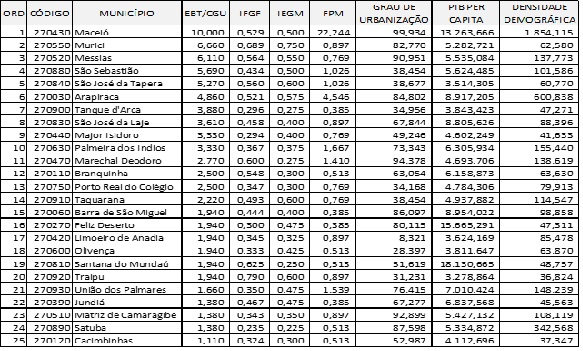
Source: Own Elaboration
Based on the survey of the data on the indicators of the Transparent Brazil Scale of the municipalities - BTS / GAU, MMEI / IRB, and Firjan Index of Fiscal Management - FIFM / FIRJAN, in addition to the data consultations of the Alagoan municipalities in the transparency portal of Planning and Management Secretary (SEPLAG), these were crossed, arranged, tabulated and presented in accordance with the Table N°1.
In order to correlate the variables with each other, only the indicators of 25 municipalities of Alagoas that presented information on all the variables were used. Given the lack of information, note a low degree of transparency data representation if we consider the indicators BTS, FIFM and MMEI, according to the cartogram.
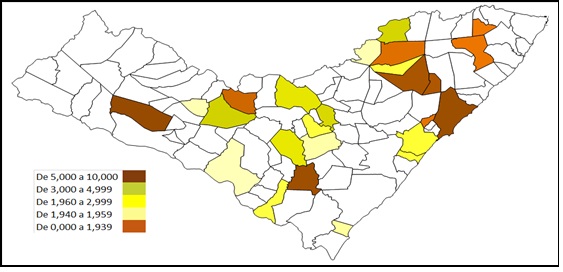
Figure Nº1. Indicators of the BTS, FIFM and MMEI with information regarding Alagoas
Source: Own Elaboration
Analysis BTS / GAU and FPM, Degree of Urbanization, GDP per capita and Demographic Density
After the tabulation, arrangement and presentation of the indices, correlations were made between the BTS / GAU indicator and the FPM indicators, Degree of Urbanization, GDP per capita and Demographic Density to verify the following hypotheses:
H 1 = There is a correlation between the BTS indicator and the FPM in municipalities of Alagoas;
H 2 = There is a correlation between the BTS indicator and the Degree of Urbanization in municipalities of Alagoas;
H 3 = There is a correlation between the BTS indicator and the GDP per capita in municipalities of Alagoas;
H 4 = There is a correlation between the BTS indicator and the Demographic Density in municipalities of Alagoas.
After carrying out the correlation between the BTS / GAU index and the variables: FPM, Degree of Urbanization, GDP per capita and Demographic Density, an F of significance of 0.004602 is presented, very low of 0.05 and the Value-p of 0.0011902 in the intersection, showing that the correlation between the variables is significant, as well as the R-Square (coefficient of determination) that has a 51.29% impact on the transparency indicator. The Cronbach's Alpha coefficient was 0.81, quite significant as well. Then, according to the above, the hypotheses can be answered and confirmed, according to the matrix presented below:
Table Nº2. Matrix of correlation between the indicators

Source: Own Elaboration
With this, the following presented hypotheses are verified:
H 1 = There is a positive and substantial correlation of 0.695 between the BTS indicator and the FPM in municipalities of Alagoas;
H 2 = There is a low positive correlation of 0.268 between the BTS indicator and the Degree of Urbanization in municipalities of Alagoas;
H 3 = There is a low positive correlation of 0.136 between the BTS indicator and the GDP per capita in municipalities of Alagoas;
H 4 = There is a substantial positive correlation of 0.665 between the BTS indicator and Demographic Density in municipalities of Alagoas.
Analysis BTS / GAU, FIFM and MMEI
After the analysis presented, new tabulations, arrangements and correlations were made between the BTS / GAU indicator and the FIFM and MMEI indicators to verify the following hypotheses:
H 5 = There is a correlation between the BTS indicator and the FIFM in municipalities of Alagoas;
H 6 = There is a correlation between the BTS indicator and the MMEI in municipalities of Alagoas;
Next, a descriptive statistic was carried out considering the relationships between the indicators, which allowed to extrapolate the normal distributions of each of them, as well as verify the reliability by means of a Cronbach's Alpha of 0.719, a significance F of 0.036235, below of 0.05, demonstrating a possible significant correlation, but with an R-square (coefficient of determination) of only 26.03%.
Table No. 3. Descriptive Statistics - Quantitative Data

Source: Own Elaboration
Table N ° 4. Descriptive Statistics - Quantitative Data

Source: Own Elaboration
After the descriptive analysis, other statistical tests were performed to calculate the correlation between the indicators and the following results were found:
Interpretation of the test:
H0: There is no significantly different correlations s 0 between variables.
Ha: At least one of the correlations between the variables is significantly different from 0.
Since the calculated p-value is less than the level of significance alpha = 0.05, the null hypothesis H0 must be rejected in favor of the alternative hypothesis Ha.
The risk of rejecting the null hypothesis H0 when this is true is less than 0.32%.
Table Nº5. Proximity matrix (Pearson correlation coefficient)

Source: Own Elaboration
The data of the descriptive statistics are those shown below and show the plot (Box Plot) and the position of the data according to the analysis of the 3 indicators and the position of the data showing a symmetric distribution in the FIFM indicators and MMEI, since they have the median in the center of the rectangle, being considered positively asymmetric:

Figure Nº2: Strip charts Plot of the EBC, IFGF and IEGM indicators
Source: Own Elaboration
The graphs that were plotted and that present the normality of each indicator are presented below, because all the indicators meet the next and regular distribution to the line of the graph.
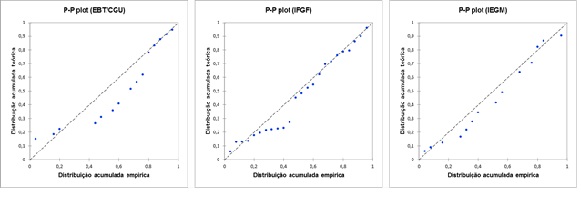
Figure Nº 3. Graphs of empirical cumulative distribution of the indicators EBC, FIFM and MMEI
Source: Own Elaboration
After the analysis presented, new tabulations, arrangements and correlations were made between the BTS / GAU indicator and the FIFM and MMEI indicators and the following hypotheses were confirmed:
H 5 = There is a positive and moderate correlation of 0.359 between the BTS indicator and the FIFM in municipalities of Alagoas;
H 6 = There is a positive and moderate correlation of 0.497 between the BTS indicator and the MMEI in municipalities of Alagoas.
Once the independence between the columns was identified, the table was constructed with the use of the Multiple Correspondence Analysis:
Table Nº6. Correlation between the indicators
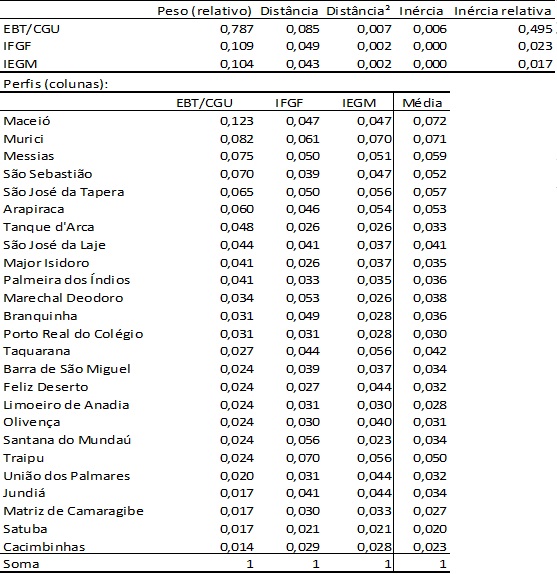
Source: Own Elaboration
After identifying the correlations, we proceeded with the correspondence analysis to test the independence between the indicators and the data identified in the municipalities, with the following results being found:
Table Nº7. Test of independence between rows and columns

Source: Own Elaboration
Interpretation of the test:
H0: The rows and columns of the table are independent.
Ha: There is a dependency between the rows and columns of the table.
Since the calculated p-value is greater than the level of significance alpha = 0, 05, the null hypothesis H0 is not rejected. The risk of rejecting the null hypothesis H0 when it is true is 100%. Tau by Goodman and Kruska is 0.032.
Next, the Burt table was verified, which is a symmetric matrix used to help visualize and analyze relationships between the variables with the result of the comparison between the BTS, FIFM and MMEI indicators, presenting a total inertia of 19.25, very significant and being adequate for the analysis of the data:
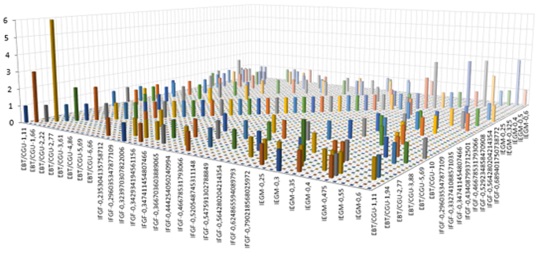
Figure N°4. 3D visualization of the Burt table
Source: Own Elaboration
Finally, a graph is presented regarding the asymmetry of the variables, suggesting a possible association between the BTS / GAU, FIFM / FIPLAN and MMEI / IRB indicators:
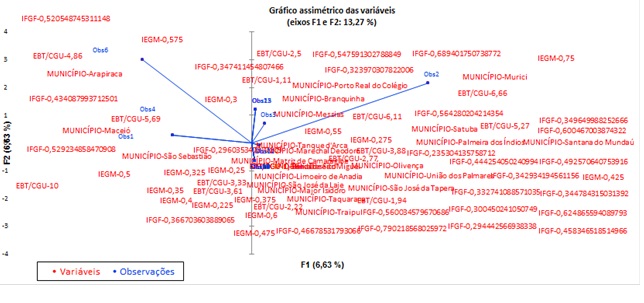
Figure 5. Asymmetric graph of the variables
Source: Own Elaboration
The interpretation is that there is an asymmetry between the indicators and municipalities, because when the data start near the origin, it can be thought that the variable has a significant association with its most frequent category and that points distant from the origin indicate the opposite, that is, that the variable has a significant association with a category that is not the most frequent.
CONCLUSION
This work sought to compare indicators of transparency and results through the results in official bodies, seeking relationships between them, from the perspective of giving continuity to the discussions on electronic governance through their public portals, as well as making available the results for the Alagoan society. In addition, as specific objectives, a correlation of the results of the BTS / GAU, MMEI / IRB, FIFM / FIRJAN indices with other indices of socioeconomic nature of the investigated municipalities was sought.
They were analyzed indicators of transparency, management and results through analysis of indexes of 25 municipalities of Alagoas, compared with each other and then presents n do that there is positive correlation between them and the existence of association between indicators, what is important to continue the studies in this line. However, when the 102 municipalities were analyzed, only 25% presented research conditions, which means that even the requirements of electronic governance and transparency required by legislation and by society itself for the practice of citizenship and political participation are not present, however, the official transparency indicators have similarities and normality in the presented results, but it is still distant of its own and essential function of presenting the reality of the administration for society and for the practices of democracy and popular participation.
The study presents limitations precisely due to the lack of information in Alagoan municipalities, suggesting that for future studies this research be extended to other studies or groups of municipalities with similar characteristics.
Finally, it is verified that it is important to continue accompanying and correlating the various indicators of control, management and outcome, as many municipalities do not adopt practices of digital governance in general, despite the possibility of implementing a simple, such as availability of legislation, public documents, information on bids and tenders, financial statements, contacts of managers and news about important events in the municipality.
REFERENCES
Please refer to articles in Spanish Bibliography.
BIBLIOGRAPHCIAL ABSTRACT
Please refer to articles Spanish Biographical abstract.












